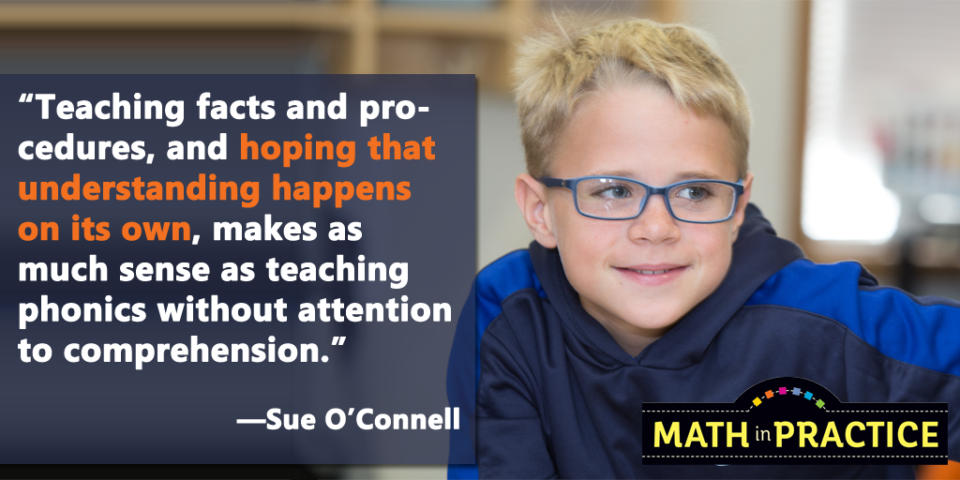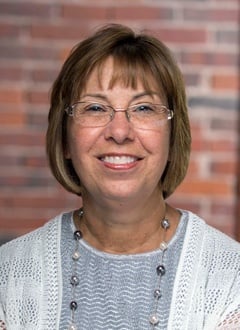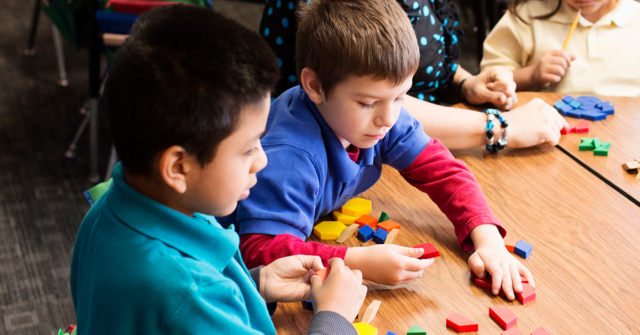
By Sue O’Connell, adapted from A Guide for Teachers, part of the Math in Practice resource.
What does it mean to be good at math? For many of us, it was about memorizing our maths, following the standard algorithm, and getting the right answers. Elementary math was about memory, speed, and right answers, right? And if we could do those things we were rewarded with good grades.
But is that true today?Is that how we should think about math instruction, whether we’re teaching remotely or in person?
Today our expectations for students go well beyond the ability to memorize math facts and perform basic computations. While those skills are important, we recognize them as just a part of what our students need to know and be able to do. We expect our students to understand math, think mathematically, and be able to use the math they have learned.
This blend of rote skills and thinking skills is not a new idea in teaching. In reading we recognize that basic skills alone do not make you a reader. Just because a student is adept at phonics and can name sight words does not mean he can read. How many students have you seen who can call out words, but don’t understand what they are reading? Without comprehension, calling out words is simply a rote process.
Teaching facts and procedures, and hoping that understanding happens on its own, makes as much sense as teaching phonics without attention to comprehension. The result is the acquisition of rote skills on a very weak foundation of memory and with little hope for application. We want more for our students. Our students’ performance on international tests shows that they are more proficient in computations than in reasoning, justifying, or problem solving (Heibert, 2003) and that their performance falters when more complex situations are posed.
So, if memorizing math facts and standard algorithms does not make a mathematician, what skills are missing? Beyond procedural fluency, what do we want our students to know and be able to do?
Here are 10 things we want our students and to consider when planning instruction:
1. Understand the big ideas of math.
So much of mathematics makes sense when you understand the big ideas. When students understand the counting sequence, place value, properties, and the ways in which numbers work, math makes sense to them.
2. Create models of math ideas.
We want our students to act out situations, use concrete objects, draw pictures and diagrams, or use abstract symbols to express math ideas. Modeling math ideas pushes our students to think deeply about the ideas, provides a way for them to show their understandings and justify their thinking, and allows them to simplify math tasks and solve math problems.
3. Have computational fluency.
We want our students to be able to use their math understandings to efficiently perform a variety of computations, including computations with whole numbers, fractions, and decimals.
4. Have a strong sense of numbers.
We want our students to develop a strong understanding of numbers that allows them to compose or decompose numbers as needed, perform computations in varied ways, make sense of various number representations, make predictions, interpret solutions, and understand when solutions make sense.
5. Understand the math procedures they do before memorizing them.
While we still value efficient procedures, we want our students to understand what they are doing and why it works. When students explore math procedures through models and discussions, not only do the procedures make sense, but students discover important ideas about how math works. Armed with understanding, students are better able to apply their knowledge to new situations or problems. By first exploring math procedures through discussions and place value models, our students develop a solid foundation which later helps them make sense of standard algorithms.
6. Understand how math ideas are connected.
Math is a series of interconnected concepts and skills, not a set of isolated skills. Seeing connections between math ideas allows students to continually build their math knowledge. As our students explore addition, they connect it to previous experiences with counting on. As they explore tools for measurement, they think about the fraction number lines they have created. As they explore area measurement, they reflect back on the use of arrays in multiplication. As they explore decimal subtraction, they connect the new procedure to the known procedures for whole number subtraction and decimal addition. The interconnectedness of math ideas allows our students to build on previous knowledge and discover important insights.
7. Solve a variety of math problems.
We want our students to know more than how to add, subtract, multiply, and divide. We want them to be able to apply math skills to real situations. We want them to know when to add, subtract, multiply, or divide. We want them to have a strong repertoire of skills and strategies to be able to solve complex math problems.
8. Reason mathematically.
We want our students to reason through math tasks, to analyze data, to discover insights, to test conjectures, and to draw conclusions.
9. Communicate their math ideas.
We want our students to be able to precisely explain their strategies, defend their answers, describe math concepts, summarize their findings, and explain their conclusions. We want them to communicate about math in talk and writing in order to process their ideas and refine their own thinking, and in order to show us and others what they know.
10. Have a positive disposition.
We want our students to feel confident in their math abilities, to be willing to take risks, and to persevere during complex tasks. We want them to love math!
♦ ♦ ♦ ♦
Learn more about Math in Practice, a K-5 support resource for teachers. Click here to download a digital sampler or visit MathInPractice.com to learn more.

Sue O’Connell has decades of experience supporting teachers in making sense of mathematics and effectively shifting how they teach. A former elementary teacher, reading specialist, and math specialist, she is also a nationally known speaker and education consultant who currently directs Quality Teacher Development, an organization committed to providing outstanding math professional development for schools and districts across the country.


